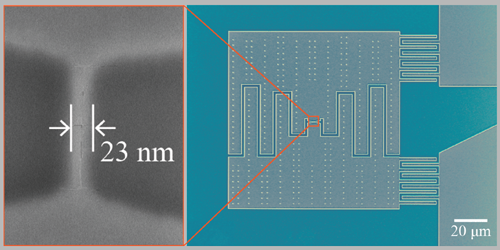New Amplifier Works in High Magnetic Fields
Superconducting parametric amplifiers are useful for many applications, from quantum computing to ultrasensitive searches for new physics. But the standard design based on Josephson junctions has a big drawback: it doesn’t work in the strong magnetic fields required by many experiments. Now Mingrui Xu and his colleagues at Yale University have shown that another type of superconducting amplifier—a nanobridge kinetic-inductance parametric amplifier (NKPA)—not only tolerates such fields but can work as well as state-of-the-art Josephson-junction-based amplifiers [1].
To understand parametric amplification, consider a child on a swing. By changing the position of their legs as they swing, the child modulates the natural frequency of the pendulum motion. If they do this at a specific frequency—twice the frequency of the motion—they can amplify the oscillation, driving the swing higher and higher. A superconducting parametric amplifier works similarly: a small signal can be amplified by a resonator if the resonator is modulated at twice its natural frequency.
While traditional superconducting amplifiers modulate this frequency using a Josephson junction, an NKPA changes the frequency by adjusting the inductance of electrons through a 23-nm-wide nanobridge. While kinetic-inductance amplifiers are not new, this is the first of its kind to achieve a performance comparable to those based on Josephson junctions.
Next, Xu and his colleagues plan to use their NKPA to read out the spin state of an electron in a magnetic field. They think that in the future their amplifiers might be useful as detectors for dark matter or other new particles.
–Katie McCormick
Katie McCormick is a freelance science writer based in Sacramento, California.
References
- M. Xu et al., “Magnetic field-resilient quantum-limited parametric amplifier,” PRX Quantum 4, 010322 (2023).




